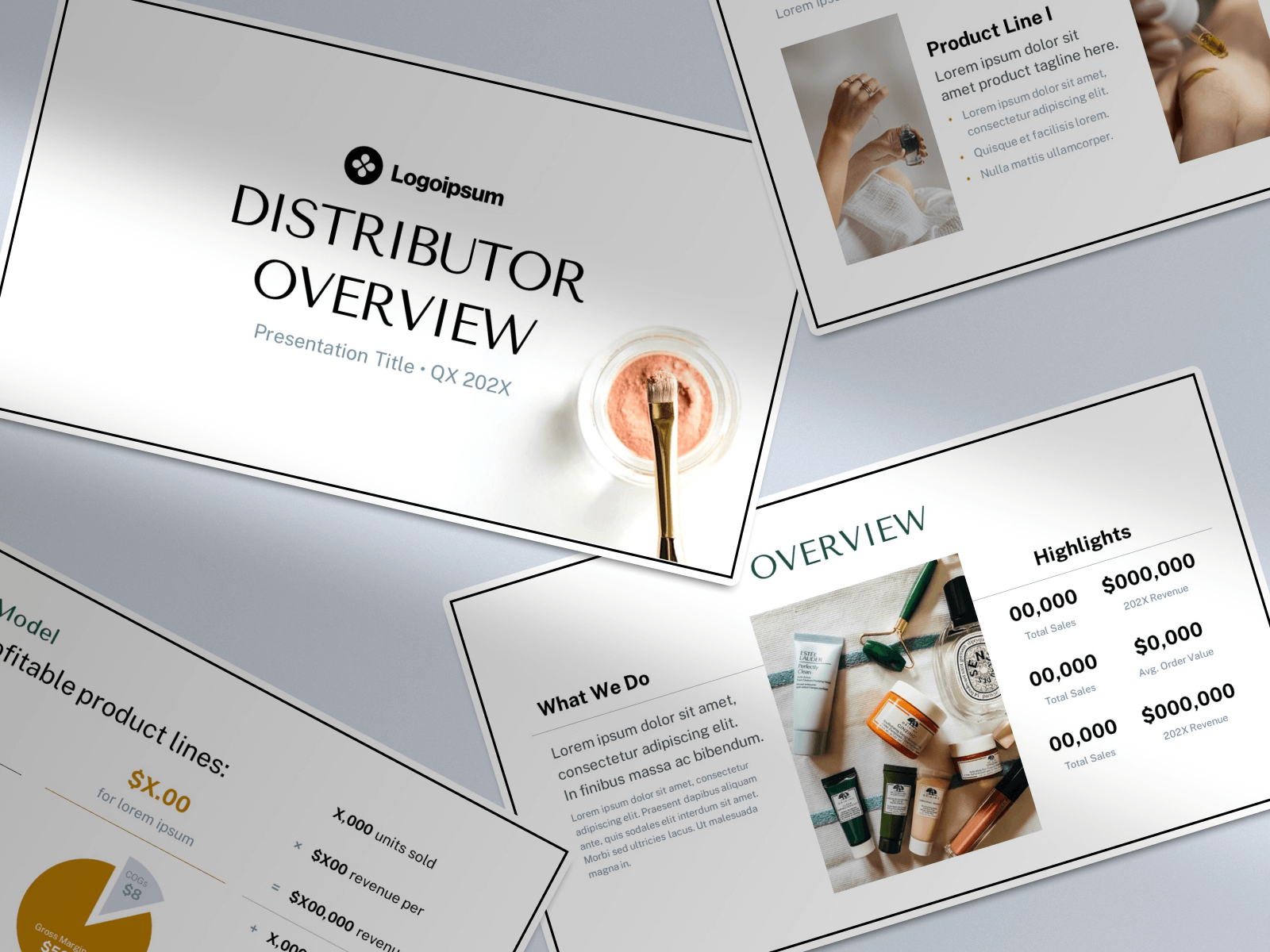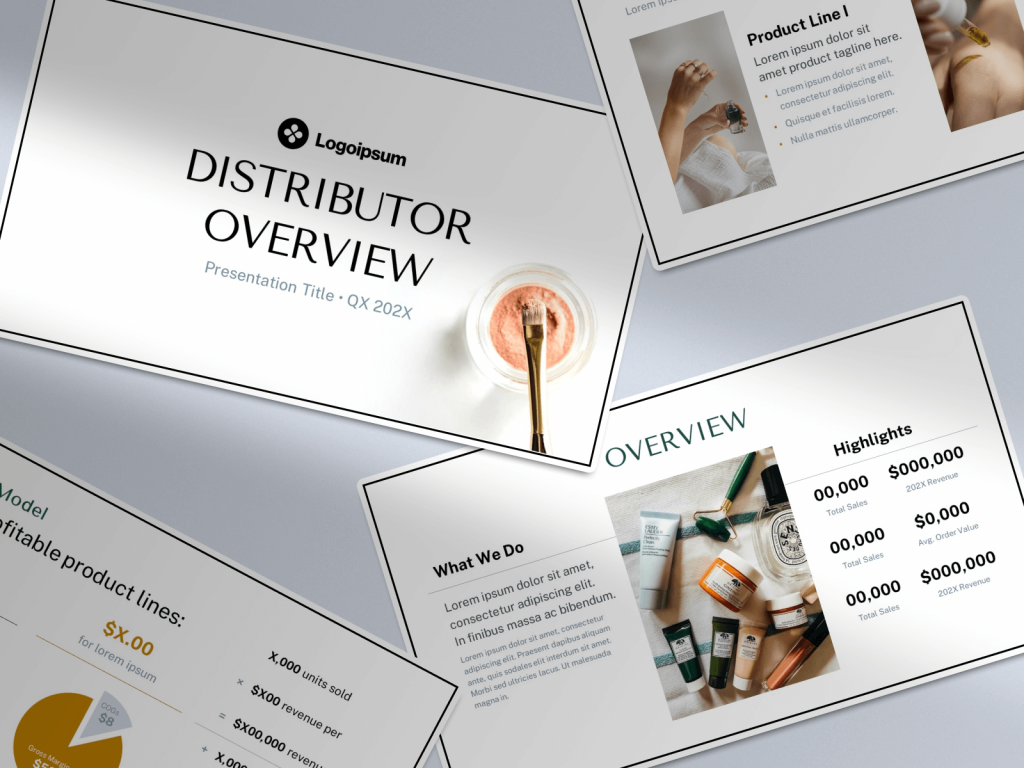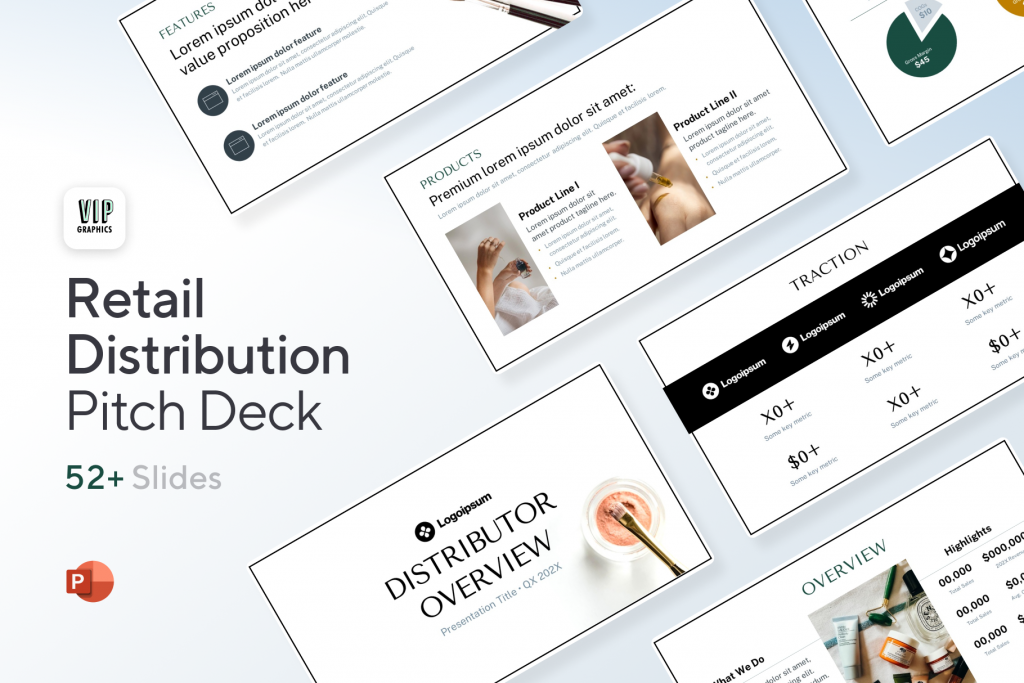Every consumer products (CPG) brand eventually hopes to be stocked in big-box stores. Direct-to-consumer (DTC) brands are no exception; former online-only products like Casper, Harry’s, and Barkbox are now available in retail locations like Walmart and Target.
For CPG brands looking to expand into retail stores, crafting a compelling distributor pitch deck is a crucial preliminary step. Retail buyers and distribution companies will almost always ask for your distributor pitch deck when you first approach them. The topics in this document will differ from those in your investor pitch deck, so you cannot simply copy and paste what you already have.
Our team of expert pitch designers have helped nascent CPG brands win millions in deals with leading retailers like Target, Walmart, 7-11, Southern Glazers, and more. In this article, we will discuss how to create the perfect distributor pitch deck:
What is a distributor pitch deck?
The distributor pitch deck is an important tool for CPG brands to get on the shelves of big-box retailers. The goal is to convince retailers to carry the brand’s products and bring them to a wider audience. Retailer / distributor pitch decks highlight the key factors that make the brand stand out, such as target market, go-to-market strategy, product differentiators, traction, and team experience. The deck is usually presented to key decision-makers at retail and distribution companies to prove the value of the brand and its products. A well-crafted pitch deck can be the difference between success and failure when it comes to getting CPG products into retail stores.
How to create a retailer / distributor pitch deck
Are you looking to pitch your business to potential retailers or distributors? A pitch deck provides a brief overview of your products in order to convince retailers or distributors to partner with your business. In this article, we will take you through the steps to create a winning retailer / distributor pitch deck that will impress your audience and help you secure the partnerships you need to grow your business.
1. What We Do / Overview Slide
The first slide of your pitch deck should be a high-level overview of what your business does and what problem it solves. This slide should give your audience a clear understanding of the purpose of your business and what sets it apart from others in the industry. Keep it simple and to the point. Highlight the most important aspects of your business and what makes it unique.
2. Product Slide
The product slide should offer an in-depth look into the product or service you are offering. This slide will generally include some photos of your product and a high-level overview of the benefits and differentiators. Be sure to highlight the key features and benefits of your product, and what sets it apart from others on the market.
3. Market Analysis / Target Market Slide
Next, retailers and distributors will want to know who the target customer is for your products. This slide generally takes the form of customer avatar or demographics overview — but you should also include some numbers regarding the size of the market as a whole. Distributors will want to see that there is growing demand and a large consumer base for your products. The market analysis slide should describe the size of your target market, who your target customers are, what their needs / pain points are, and why they will be interested in your product. You should also highlight the competition in the market and why your product is the best solution.
4. Go-to-Market / Channel Strategy Slide
Your distributor pitch deck should demonstrate that you have a robust plan to bring your product to market. The go-to-market strategy is the key to doing so, and generally describes the channels you will use to reach your target market. Be sure to address both growth channels (ie. social media, advertising) and distribution channels (ie. retail partners, eCommerce). If your product is already in-store at big box retailers, this is a great place to highlight their logos or include a map visualizing your geographic retail footprint.
5. Traction Slide
The traction slide is all about showing the progress and success your company has achieved. This should include quantifiable figures such as the number of orders / units sold, revenue generated (and growth rate), as well as any awards or recognition your products have received — along with any other key milestones you have reached. The objective of this slide is to convince potential partners that you are a business on the rise and that they should seriously consider carrying your products.
6. Advantage / Differentiators Slide
The consumer goods (CPG) space is highly competitive, and your product will be pitted against larger brands for shelf space. The advantage slide should speak to what sets your product apart from others in the market. Why will consumers purchase your products over others? Speak to your unique value proposition, secret sauce, proprietary/patented technology, or any other advantage you have over the competition. You should make it clear why your product is the best choice for retailers and distributors in the segment you operate in.
7. Pricing Slide
No distributor pitch deck is complete without a pricing slide. This slide generally includes both wholesale and retail pricing, as well as your cost of goods (COGs) and profit margins. Distributors and retailers will be looking to confirm they can earn a healthy margin by carrying your products.
8. Financials Slide
This slide is important because it shows potential investors and partners that you have a good understanding of your business’s finances. On this slide, you should include information like your revenue, profit, expenses, and projections for the future. If you have a history of strong financial performance, make sure you highlight that. If you’re just starting out, make sure you explain your plan for becoming profitable. Be honest about your financial situation, but also make sure you’re optimistic about the future.
9. Team Slide
At the end of the day, your partners will want to know the people behind the business they are working with. Everyone likes to do business with people they know and trust. The team slide should introduce your team’s roles and experience. This is a great place to speak to the origin story of your business, as well as demonstrating that you have robust in-house capabilities to support national distribution. If your team has any special qualifications (ie. veteran, minority, or female-owned), be sure to highlight these — many companies have supplier diversity requirements to fulfill, which can boost your chances of success.
10. Call-to-Action Slide
Every effective pitch deck concludes with a call-to-action (CTA). This slide should clearly state what an interested partner should do next. Generally, this page will include the contact information for your company’s Head of Sales and/or the founder/CEO. Give the reader an easy way to get in touch with you, like an email address or phone number. Don’t make the mistake of confusing readers with multiple different options — stick to one clear & concise CTA.
Need help with your distributor pitch deck?
The distributor pitch deck is an essential tool for CPG brands who want to secure partnerships with distributors and big-box retailers. You might be interested in the popular Distributor Pitch Deck Template designed by our team at VIP.graphics: cutting-edge slides design by experts who have helped secure millions in deals with top retailers like Walmart, Starbucks, Target, and 7-11. Creating a professional-grade retail distribution pitch deck is quick and easy with this template — check it out here.


